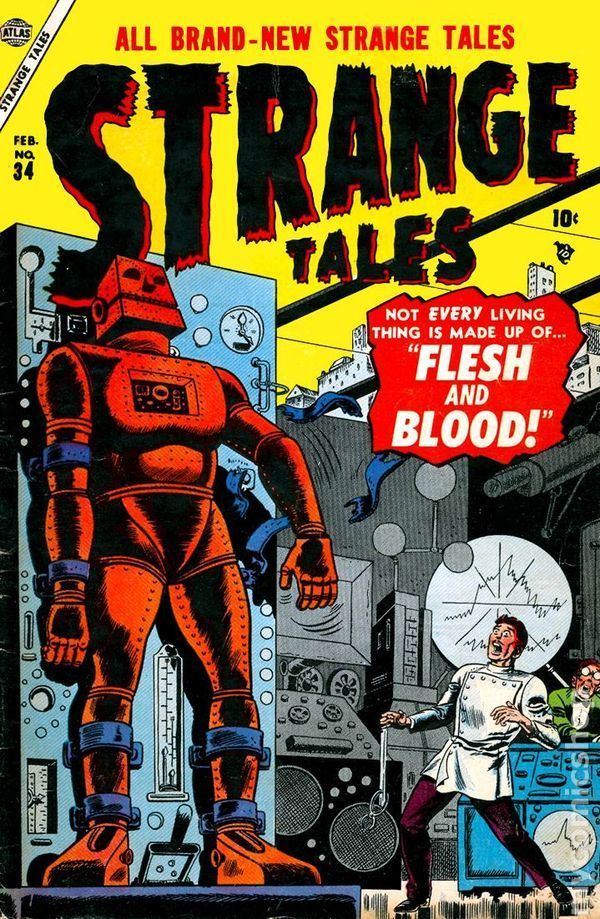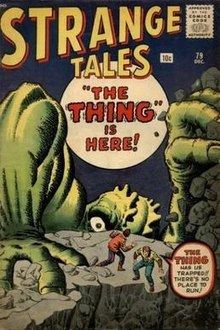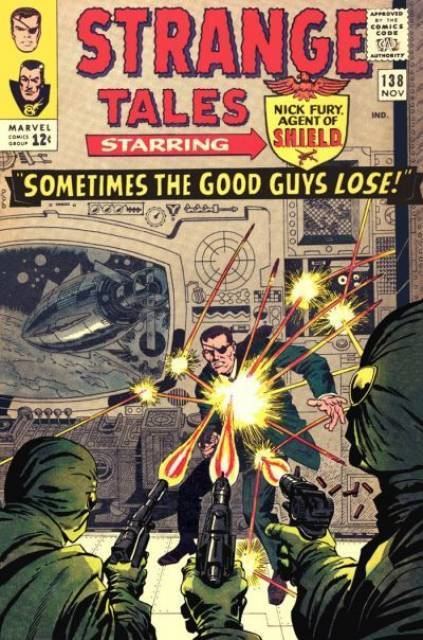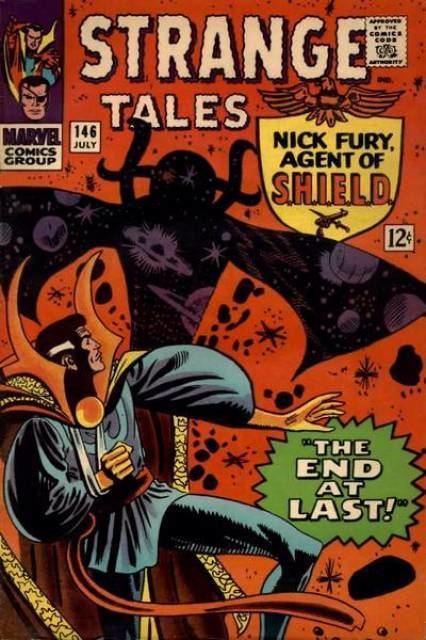 | ||
Schedule Bimonthly, June 1951 – June 1952; monthly, July 1952 – Oct. 1953; bimonthly, Nov. 1953 – Feb. 1954; monthly, March 1954 – Aug. 1954; bimonthly Oct. 1954 – April 1955; monthly, June 1955 – June 1957; bimonthly Dec. 1957 – Oct. 1960; monthly, Nov. 1960 – May 1968 Publication date (vol. 1) June 1951 – May 1968(vol. 1 revival) Sept. 1973 – Nov. 1976(vol. 2) April 1987 – Oct. 1988 Number of issues (vol. 1) 168(vol. 1 revival) 20 (#169–188)(vol. 2) 19 Similar Tales of Suspense, Tales to Astonish, Strange, Journey into Mystery, Sgt Fury and his Howling | ||
Holy grail pick up epic strange tales collection
Strange Tales is a Marvel Comics anthology series title that appeared and was revived in different forms on multiple occasions throughout the company's history. The title introduced the features "Doctor Strange" and "Nick Fury, Agent of S.H.I.E.L.D.", and was a showcase for the science fiction/suspense stories of artists Jack Kirby and Steve Ditko, and for the groundbreaking work of writer-artist Jim Steranko. Two previous, unrelated magazines also bore that title.
Contents
- Holy grail pick up epic strange tales collection
- 1st doctor strange issue strange tales 110 1963 comic book story time
- Monsters and magician
- Steranko and spies
- Warlock and Brother Voodoo
- Cloak and Dagger
- Volumes 3 and 4
- Strange Tales MAX
- Circulation figures
- Collected editions
- References

1st doctor strange issue strange tales 110 1963 comic book story time
Monsters and magician

The Marvel Comics series ran 168 issues, cover-dated June 1951 to May 1968. It began as a horror anthology from the company's 1950s precursor, Atlas Comics. Initially modeled after the gory morality tales of the popular and groundbreaking EC line of comics, Strange Tales became less outré with the 1954 imposition of the Comics Code, which prohibited graphic horror, as well as vampires, zombies and other classical monsters.

The comic changed again with the return of industry stalwart Jack Kirby, the artist who had co-created Captain America for the company then worked elsewhere for 17 years. Starting with #68 (April 1959), Strange Tales was revamped to reflect the then-current trend of science fiction drive-in movie monsters. Virtually every issue would open with a Kirby monster story (generally inked by Christopher Rule initially, then later Dick Ayers), followed by one or two twist-ending thrillers or sci-fi tales drawn by Don Heck, Paul Reinman, or Joe Sinnott, all capped by an often-surreal, sometimes self-reflexive Stan Lee-Steve Ditko short.
Some characters introduced here in standalone, anthological stories were later retconned into Marvel Universe continuity. These include Ulysses Bloodstone in the story "Grottu, King of the Insects!" in issue #73 (Feb. 1960), the extraterrestrial dragon Fin Fang Foom, who first appeared in #89 (Oct. 1961), and the extraterrestrial would-be world conquerors Gorgolla, introduced in #74 (April 1960), and Orrgo, introduced in #90 (Nov. 1961).
In Strange Tales #75 (June 1960), a huge robot called "the Hulk" appeared. It was actually armor worn by the character Albert Poole. In modern-day reprints the character's name is changed to Grutan.
Prototypes of the Spider-Man supporting characters Aunt May and Uncle Ben appeared in a short story in Strange Tales #97 (June 1962).
The anthology switched to superheroes during the Silver Age of Comic Books, retaining the sci-fi, suspense and monsters as backup features for a time. Strange Tales' first superhero, in 12- to 14-page stories, was the Fantastic Four's Human Torch, Johnny Storm, beginning in #101 (Oct. 1962). Here, Johnny still lived with his elder sister, Susan Storm, in fictional Glenview, Long Island, New York, where he continued to attend high school and, with youthful naivete, attempted to maintain his "secret identity" (later retconned to reveal that his friends and neighbors knew of his dual identity from Fantastic Four news reports, but simply played along). Supporting characters included Johnny's girlfriend, Doris Evans, usually seen only in consternation as Johnny cheerfully flew off to battle bad guys. Ayers took over the penciling after 10 issues, later followed by original Golden Age Human Torch creator Carl Burgos and others, with Superman co-creator Jerry Siegel scripting issues #112–113 (Sept.–Oct. 1963) under the pseudonym "Joe Carter". The Fantastic Four made occasional cameo appearances, and the Thing became a co-star with #123 (Aug. 1964). Strange Tales Annual #2 (1963) featured the first team-up of Spider-Man and the Human Torch.
The title became a "split book" with the introduction of sorcerer Doctor Strange, by Lee and artist Steve Ditko. This 9- to 10-page feature debuted in #110 (July 1963), and after an additional story and then skipping two issues returned permanently with #114. Ditko's surrealistic mystical landscapes and increasingly head-trippy visuals helped make the feature a favorite of college students, according to Lee himself. Eventually, as co-plotter and later sole plotter, in the "Marvel Method", Ditko would take Strange into ever-more-abstract realms, which yet remained well-grounded thanks to Lee's reliably humanistic, adventure/soap opera dialog. Adversaries for the new hero included Baron Mordo introduced in issue #111 (Aug. 1963) and Dormammu in issue #126 (Nov. 1964). Clea, who would become a longtime love interest for Doctor Strange, was also introduced in issue #126.
Though Lee and Ditko themselves interacted less and less as each went their separate creative ways, the storyline culminated with what fans and historians consider one of modern comics' milestones: the introduction, in issue #138 (Oct. 1965), of Ditko's enduring conception of Eternity, the personification of the universe. Depicted as a majestic silhouette whose outlines are filled with the cosmos, Eternity soon becoming a cornerstone of the Marvel mythos. It was a groundbreaking creation long before such cosmic conceits were commonplace. Issue #146 (July 1966) marked Ditko's final bow on the series. Bill Everett succeeded him through #152 (January 1967), followed by Marie Severin (self-inked for four issues before being inked by future Hulk signature artist Herb Trimpe in some of his earliest Marvel work). Another cosmic entity, the supremely powerful the Living Tribunal, was introduced during Severin's run, in issue #157. Dan Adkins took over penciling duties from #161 (Oct. 1967) to the final issue, #168 (May 1968).
Steranko and spies
The Human Torch and Thing had already been replaced in #135 (Aug. 1965) by Nick Fury, a superspy in keeping with the concurrent James Bond/The Man from U.N.C.L.E. craze. The 12-page feature was initially by Lee and Kirby, with the latter supplying such inventive and enduring gadgets and hardware as the Helicarrier – an airborne aircraft carrier – as well as human-replicant LMDs (Life Model Decoys), and even automobile airbags. Marvel's all-purpose terrorist organization HYDRA was introduced here as well.
The feature "Nick Fury, Agent of S.H.I.E.L.D." soon became the province of writer-penciler-colorist Jim Steranko, under whom it became one of the creative zeniths of the Silver Age. Steranko introduced or popularized in comics such art movements of the day as psychedelia and op art, built on Kirby's longstanding work in photomontage, and created comics' first four-page spread – again inspired by Kirby, who in the Golden Age had pioneered the first full-page and double-page spreads. All the while, he spun plots of intense intrigue, barely hidden sensuality, and hi-fi hipness – and supplying his own version of Bond girls, essentially, in skintight leather, pushing what was allowable under the Comics Code at the time.
"Nick Fury, Agent of S.H.I.E.L.D." became the first Strange Tales feature to receive its own cover logo below the main title, beginning with #135; it skipped an issue before returning permanently with #137. "Doctor Strange" received its own cover logo, designed by Sol Brodsky, with Strange Tales #150 (Nov. 1966).
Warlock and Brother Voodoo
Strange Tales temporarily ended with #168 (May 1968). The following month, Doctor Strange's adventures continued in the full-length Doctor Strange #169, with Nick Fury moving to the newly launched Nick Fury, Agent of S.H.I.E.L.D.
Doctor Strange was canceled with #183 (Nov. 1969). Four years later, Strange Tales resumed at its old numbering with #169 (Sept. 1973), which introduced the supernatural feature Brother Voodoo by writer Len Wein and artist Gene Colan. This lasted only to issue #173 (April 1974), with Brother Voodoo continuing briefly in the black-and-white Marvel horror-comics magazine Tales of the Zombie. This was followed by two different creative teams producing three stories of The Golem in four issues (#174–177), the second of these a fill-in monster-reprint issue.
The next feature was writer-artist-colorist Jim Starlin's take on Adam Warlock, picking up the character from the 1972–73 series Warlock (a.k.a. The Power of Warlock) and reviving him in Strange Tales #178 (Feb. 1975). Another creative high-water mark, this feverishly imaginative feature from Starlin, who had similarly reinvigorated Captain Marvel, introduced the Marvel characters Gamora, Pip the Troll and The Magus, and helped establish the mythos Starlin would mine in his many "Infinity" sagas of the 1990s. After issue #181 (Aug. 1975), the story would continue in Warlock #9 (Oct. 1975), picking up from the old series' numbering. Strange Tales soldiered on with Doctor Strange reprints through issue #188 (Nov. 1976).
Cloak and Dagger
After Doctor Strange's second series was canceled in the 1980s, Strange Tales was relaunched as vol. 2, #1 (April 1987). A split book once again, it featured 11-page Doctor Strange and Cloak and Dagger stories, the latter continuing from Cloak and Dagger #11. This ended with issue #19 (Oct. 1988), after which new Doctor Strange and Cloak and Dagger series were launched.
Volumes 3 and 4
A one-shot Human Torch, Thing, and Doctor Strange story, by writer Kurt Busiek, with painted art by Ricardo Villagran, was released in squarebound bookshelf format in 1994. Another one-shot, the 52-page Strange Tales: Dark Corners in 1998 was an anthology featuring Morbius the Living Vampire, the Gargoyle, Cloak and Dagger, and Spider-Man. A Strange Tales miniseries featuring Man-Thing and Werewolf by Night was published in 1998 to tie up plotlines after their individual series had been canceled. Although four issues were solicited, only two issues of this volume saw print, and the conclusions of those storylines were never released.
Strange Tales MAX
In 2009 Marvel published a three issue miniseries under the MAX imprint. It featured comics writers and artists who normally create comics outside the superhero genre, such as Stan Sakai, Jason, and Michael Kupperman, and later was collected as a trade paperback. A second volume, Strange Tales II was published in 2010 and included work by Harvey Pekar, Dash Shaw, and Jhonen Vasquez.
Circulation figures
From annual required Statement of Circulation. "Average circulation" refers to total print run. "Total paid circulation" refers to number of copies actually sold, which is the above number minus returns, lost/damaged copies, and free/promotional copies.
Strange Tales vol. 1
Circulation figures from annual statements, charted as per-issue average paid circulation by Miller, John Jackson, et al., The Standard Catalog of Comic Books, Krause Publications 2002, pp. 1007–1009
Circulation figures from Capital City Distribution orders, charted as per-issue paid circulation by Miller, John Jackson, et al., The Standard Catalog of Comic Books, Krause Publications 2002, p. 1009
